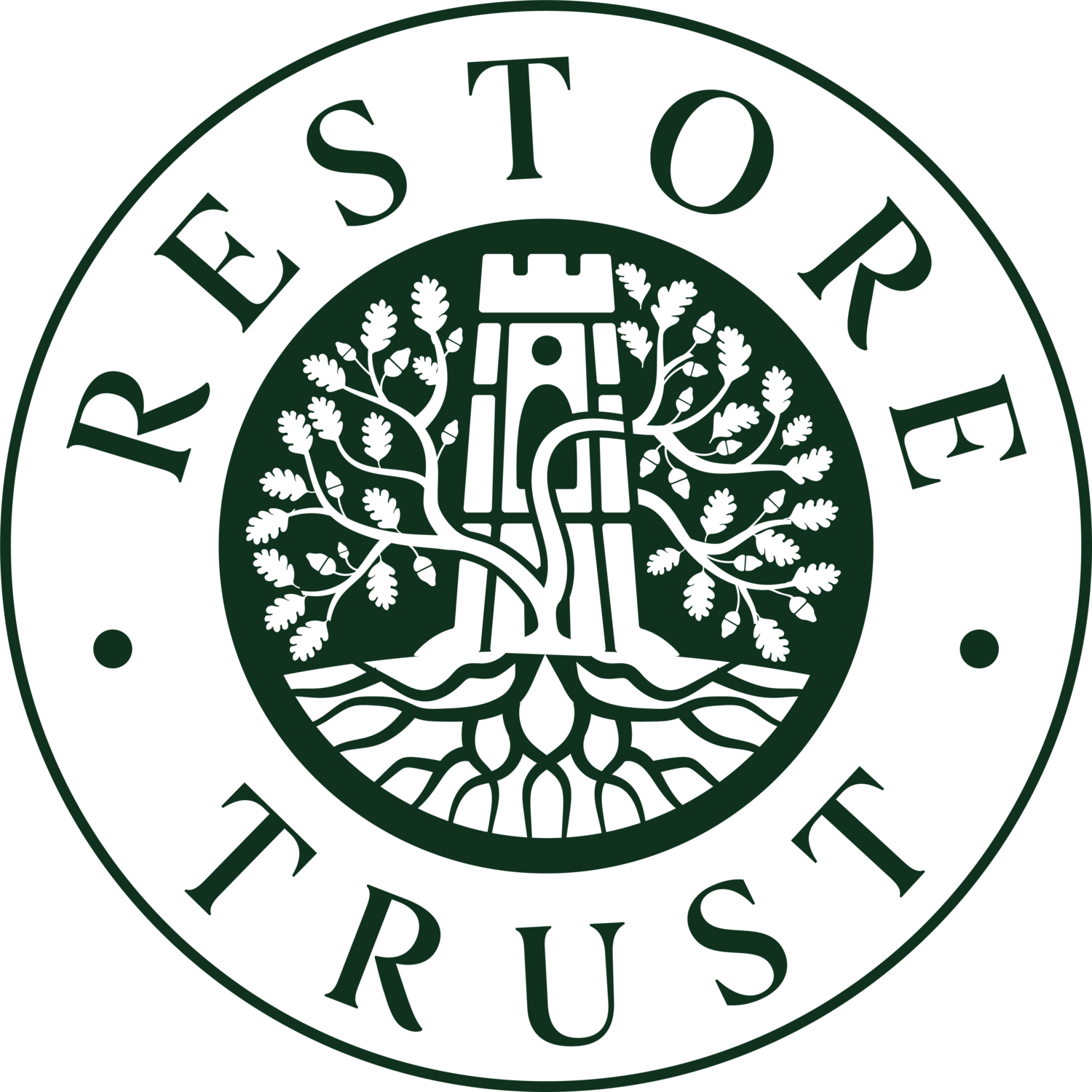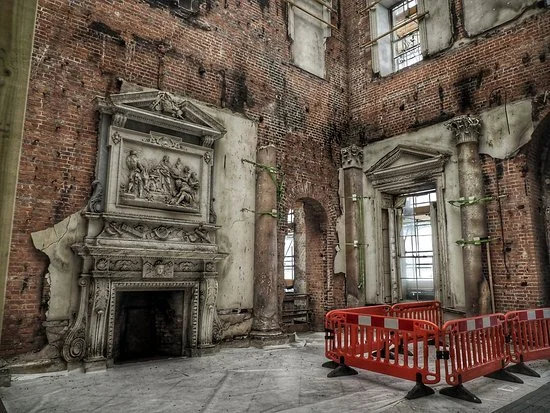The Anti-Restoration of Clandon Park
Brice Stratford is alarmed at the National Trust’s plans for a modernist reconstruction of Clandon Park and proposes a more sensitive approach.
There has been no greater loss to or controversy surrounding a National Trust property in recent years than the sorry case of Clandon Park House. The Grade I listed, early 18th century mansion house, home to the Earls of Onslow for centuries, was passed to the Trust in 1956 to preserve in perpetuity the extraordinary heritage building, alongside its countless accrued artefacts, for future generations. After just sixty years it burned down. Badly. Completely gutted, the cultural and historical loss is incalculable. The cause is tentatively reckoned to be a fault in the fuse board; apparently the cupboard where it was held was insufficiently protected against fire, and previous works to wall cavities had left excessive, flammable rubbish throughout the building structure. No responsibility was taken by the Trust, no apology was given to the nation, no lessons were learned.
A little less than a year after the fire, on January 18th of 2016, the Trust announced its ‘ambitious plans for Clandon Park’ which will ‘create vibrant, modern spaces to breathe new life into the house.’ In so doing they unintentionally showed their cards, confirming that they only intend to ‘restore the magnificent state rooms on the ground floor – the most architecturally important and beautiful rooms.’ By definition, then, their modernising plans for the rest of the house are not restoration, but rather something else. Therein lies the rub. When the current Earl of Onslow expressed the opinion that the house should be left as a ruin and the money put to better use, the Trust responded that the insurance payout can only legally be spent on restoration of the original house. And that’s not all.
‘The National Trust shall be established for the purposes of promoting the permanent preservation for the benefit of the nation of lands and tenements (including buildings) of beauty or historic interest and as regards lands for the preservation (so far as practicable) of their natural aspect features and animal and plant life.’
This passage comes from the very Act of Parliament (and its descendants) which in 1907 elevated the Trust to the expansive, sprawling property magnate it is today. It exists as it does now thanks to special privileges granted on the basis of this simple, legally established obligation. It has grown rich from generations of taxation, which forced the most valuable and important remnants of our history out of private ownership, justified by strict adherence to this lawfully defined purpose.
On the 9th of March, 2017, the Trust launched ‘an international design competition welcoming global submissions from designers and architects’, offering ‘talented teams the extraordinary opportunity to apply their expertise and creative thinking within this significant historic building.’ On the 24th of May a shortlist of six was announced, alongside the jury that would make the final decision. The jury chosen to decide how best, exactly, to ‘create vibrant, modern spaces’ and ‘to breathe new life’ into Clandon in the hope of better reflecting and attracting new and future generations is, of course, almost entirely made up of people in their late 60s and 70s, with a couple in their 50s and one in their 80s. In another, more traditional restoration an average age of 68 could be a strength, emphasising accrued knowledge and greater experience of the very traditions that they seek to replicate and continue, but by definition what is cutting-edge and new to a room full of 68 year olds is already dated, old-fashioned and redundant to the 20 year olds next door.
On December 6th, 2017, the jury made their decision, and chose the architects Allies and Morrison to ‘restore, rebuild and reimagine’ Clandon Park House. The selected designs are predictable late 20th century Scandi-modernism, all glass-boxes and featureless, minimalist walls. It would have been a fresh, interesting take 30-40 years ago, but is already stale, generic and overused in 2021, before it’s even been built. The priority has not been to uncover or elucidate or better appreciate the original building, but rather to create something unrecognizable and new which serves a fundamentally different and unrelated purpose. This simply isn’t restoration, and is certainly not ‘promoting … permanent preservation’. On the contrary, it actively discourages it.
The original house was (and is) a work of art in its own right; the proposals are to turn it into a blank canvas white box and flexible events venue on which other art can be placed and enjoyed, but which has no real value in and of itself beyond as an understated gallery space which doesn’t distract from the rotating, transitory pieces displayed on the walls. This is of no comparable national value, as a building, and is demonstrably not a restoration but rather a re-development. The original house was (and is) unique and instantly recognizable, and could only have been built in a specific time and place and by the specific people involved. The redesigns could be from and in any part of the world at any point in the last three decades.
It beggars belief that not a single member of the jury was an Onslow. Had the new direction for Clandon been chosen, influenced or even just validated by the family of the Earls of Onslow then it would at least have maintained the historical continuity that has always defined it, and would have thus been twined with earlier incarnations. The future of the site would have been inextricably part of the same, living tradition as the past of the site. Instead, the human inheritors of that tradition, the very family who gifted Clandon to the Trust in the first place and were responsible for so much of its national value, were excluded.
The overtly modernizing approach seeks to obliterate the original experience and replace it with something alien and architecturally parasitic for reasons which have nothing to do with preservation or conservation of the original house. This is not a restoration, but a redevelopment and ‘reimagining’, and as such it is not something which is in the lawful purview of the National Trust, it runs contrary to the terms on which the property was gifted, and it should quite possibly be disbarred by the terms of the insurance payout. The chosen design fails to be anything more than a dated pastiche of 1990s Scandi-modernism and long-outmoded experiential concepts which will only widen the gulf between the country house and the youngest generations. In short, it’s the wrong project, and even if it were the right project, it’s the wrong choice.
I believe that the best approach to restoring Clandon is a melding of the current project with the Earl of Onslow’s preference for a preserved ruin. As has been the Trust’s intent since 2016, the downstairs floor should be truly restored and flawlessly recreated, the process thoroughly documented, and the project embraced as an opportunity to train a new generation of young craftsmen and artisans. The upper floors, however, instead of the modernist redesign which is proposed, should be kept in varying degrees of arrested decay, telling the story of the fire, but also of the construction, exposing the inner workings and craftsmanship of the house itself; different layers of restoration work can also be begun and left incomplete, creating a real-world Dorling Kindersley style cross-section of a country house, where different phases in the building process can be experienced sequentially, from burned out, ruinous shell, through gradual rebuild, and finally to the complete, 18th century original.
This is a unique opportunity to create something which simply does not exist, and which in no way undermines or obliterates the story of Clandon Park, instead adding to and enriching it. The attraction and focus of the house would remain the house itself, and not whatever event, artwork or exhibition was currently on display in the flexible white-box space. It would be three-dimensional architectural archaeology, accessible to and explorable by the public, engaging in a way that has never before been achieved. This extraordinary vision deserves the chance of life. A slim chance remains. October 30th sees the opportunity for National Trust members attending the AGM in person to make their views known and persuade the management of the Trust to think again. Later this year the Trust will appoint a new Chairman, and that person will need to have a deep knowledge of historic buildings and landscapes and a thorough understanding of the challenges they bring. Clandon Park can still be saved. I hope beyond hope that it will be.


